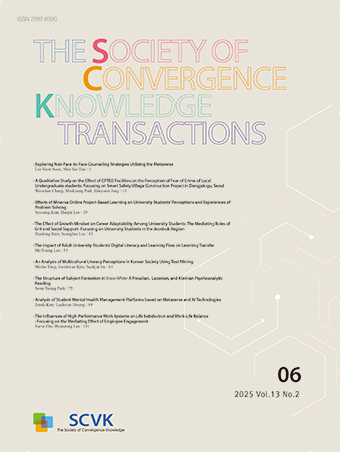Research Article
Abstract
References
Information
본 논문에서는 전기, 전자 및 통신 관련 학과에서 필수 교과목인 통신이론을 시뮬레이션 프로그램을 사용하여 수업에 적용한 사례를 연구하였다. 통신이론은 푸우리에 변환, 확률이론과 같은 수학적 배경들과 많은 블록도를 바탕으로 학습하게 되며 학부 고학년 과정에서도 난이도가 높은 과목이다. 본 논문은 진폭변조(AM, Amplitude modulation) 이론을 설명하기 위한 다양한 시뮬레이션 프로젝트를 제시하여 이러한 어려움을 극복하려는 시도이다. AM신호를 발생하기 위하여 수식, 블록도 및 다양한 소자 사용하여 이론 학습뿐만 아니라 실습도 대치할 수 있도록 개발하였다. 이 프로젝트에서는 DSB-LC(Double sideband - large carrier) 파형을 능동소자인 다이오드와 트랜지스터를 사용하여 스위칭 또는 비선형 변조회로를 구현하였다. 또한 IC 부품을 사용하여 직접 AM을 만드는 과정도 추가하였다. 시뮬레이션 결과는 기본 개념의 이해를 위하여 시간영역과 주파수영역을 강조하였다. 만들어진 AM 신호의 다양한 변수를 변화시키면서 결과 파형을 관찰하고, 학생들이 흥미를 이끌고 동기를 부여할 수 있도록 설계하였다.
In this paper, the simulation project linked with the communication theory, which is an essential subject in electrical, electronic and communication related courses is presented. Learning of communication circuit theory based on the mathematical background using Fourier transform, probability theory and many block diagrams is very challenging tasks for the senior level undergraduate students. This paper attempts to overcome this difficulty by presenting a comprehensive project that can be used to demonstrate AM (Amplitude modulation) theory. An AM waveform is produced using various ways, a simple equation, a block diagram, active devices and IC modules. Projects are developed to concrete not only theoretical background but also practice real world. In this project, the DSB-LC (Double side band - large carrier) circuit is implemented using diodes and transistors, as switching or nonlinear modulation circuits. It also includes an AM generation using IC components. The simulation results are studied via both the time and frequency domain to enhance concept understanding using PSpice. The AM projects are designed to change the variables in various ways and observe the resultant waveforms so that students can fully understand the basic concepts and motivate their interest.
- L. Miller, “ 5G RF for dummies,” Qorvo special edition, John Wiley & Sons, Inc., 2017
- C. Campbell, F. Saffih and K.Nigim, “ Improved Learning Efficiency with Integrated Math and Circuit Simulation Tools in Electrical and Computer Engineering Courses,” American Society for Engineering Education, pp. 11.730.1 – 11.730.7, 2006
- T. M. Weller, P. G. Flikkema, L. P. Dunleavy, H. C. Gordon and R. E. Henning, “ Educating Tomorrow’s RF/Microwaves Engineer : A New Undergraduate Laboratory Uniting Circuit and System Concepts,” IEEE MTT-S Digest, WE2B-7, pp. 563-566, 1998
- F. G. Stremler “Introduction to Communication System,” Addison-Wesley Publishing Company, Chap. 5 Amplitude Modulation, 2nd Ed.
- S. Haykin and M. Mother, “Communication Systems,” Wiley, Chap. 3, Amplitude Modulation, 5th. Ed., 2010
- R. Parker and W. Buchanan, “Circuit Simulators and Computer Algebra- An Integrated Curriculum for Electronics Students,” Proceedings of American Society for Engineering Education Annual Conference, 1996
- R. J. Barsanti Jr. and J. S. Skinner, “Amplitude Modulation Circuit Implementation for use in an Undergraduate Communication Course for Electrical Engineering Students, ” American Society for Engineering Education, Paper ID #18541, 2017
- “Analog Behavioral Modeling”, Cadence Application Note, 29 Dec., 2009
- P. Tobin, “PSpice for Analog Communication Engineering,” Morgan & Claypool Pulishers, Chap.1 Amplitude Modulation Techniques, 200710.2200/S00071ED1V01Y200612DCS009
- 이해영, 박지언, 손병운, “ PSpice 기초와 응용,” 정일, pp.417-421, 1999
- 11.“Low cost analog multiplier, AD633” from https://www.analog.com/media/en/technical-documentation/data-sheets/AD633.pdf
- Publisher :The Society of Convergence Knowledge
- Publisher(Ko) :융복합지식학회
- Journal Title :The Society of Convergence Knowledge Transactions
- Journal Title(Ko) :융복합지식학회논문지
- Volume : 7
- No :3
- Pages :77-86
- DOI :https://doi.org/10.22716/sckt.2019.7.3.036




 The Society of Convergence Knowledge Transactions
The Society of Convergence Knowledge Transactions







